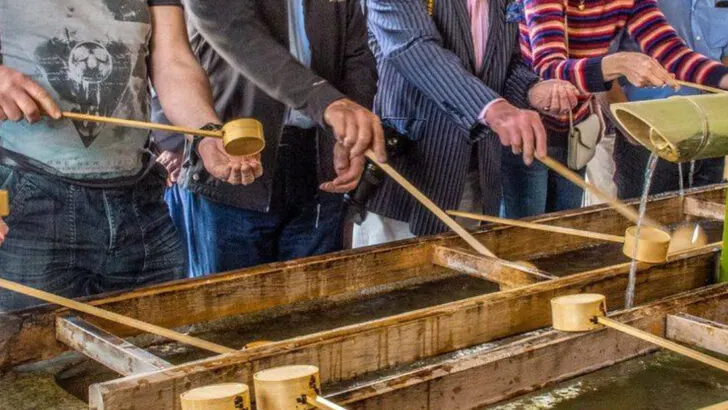Visiting a shrine in Japan isn’t just a stop on your itinerary—it’s stepping into centuries of tradition. Every gate, path, and ritual carries meaning, and knowing the rules can turn a simple visit into a deeply respectful experience. From washing your hands at the purification fountain to bowing at the right moments, each gesture shows mindfulness and appreciation for the sacred space. Even small missteps, like talking too loudly or skipping a step, can disrupt the quiet harmony that locals and pilgrims cherish. Shrines are more than photo opportunities—they’re living cultural treasures where etiquette matters as much as architecture and history. Observing the proper customs allows you to connect with the place on a level most tourists miss.
Mastering these rules doesn’t take away from the fun—it deepens it. Here’s what every visitor should know before stepping into Japan’s sacred shrine spaces.
Bowing at the Torii Gate
Approaching a shrine, one first encounters the torii gate, a symbol marking the boundary between the sacred and the profane. Visitors are encouraged to bow once before passing through; a gesture of respect and acknowledgment of the divine. This simple act sets the tone for the visit, reminding one that they are entering a place of reverence.
Did you know that the torii gate’s origins date back to the 8th century? Its presence signals a shift in space, encouraging reflection and mindfulness. By bowing, visitors align themselves with the spiritual ambiance, opening their hearts to the shrine’s tranquility.
Cleansing at the Temizuya
Before entering the shrine, purification at the temizuya is essential. This water pavilion invites visitors to cleanse their hands and mouth, symbolizing inner purity. Using a bamboo ladle, one rinses both hands and takes a sip to rinse the mouth, a practice that refreshes the spirit.
This ritual, though brief, carries profound meaning, representing the shedding of worldly impurities. The cold touch of water on the skin invigorates, preparing the visitor for the sacred space ahead. It’s a moment of pause and renewal, a cleansing of both body and mind.
Offering a Prayer
At the heart of the shrine, offering a prayer is a deeply personal act. Visitors approach the altar, tossing a coin into the offering box, then bowing twice, clapping twice, and bowing once more. This sequence of gestures connects the visitor with the divine, a dance of devotion and humility.
Each movement carries intention, from the resonant clap to the gentle bow. The practice is ancient yet timeless, echoing the prayers of countless souls who have sought solace at this sacred site. It’s an invitation to pause, reflect, and connect with something greater.
Walking Paths Respectfully
Shrine paths are more than mere walkways; they are sacred routes connecting various parts of the shrine complex. Visitors should walk on the sides, leaving the center path open for the deities. This respectful gesture honors the spiritual presence believed to traverse the central path.
With each step, one becomes part of a tradition that transcends time, joining the footsteps of those who’ve walked these paths for centuries. The atmosphere is hushed, inviting contemplation. By observing silence and mindfulness, visitors contribute to the shrine’s serene aura, enhancing their own experience.
Respectful Photography
Photography at shrines requires sensitivity and respect. While capturing the beauty of the site is natural, it’s important to avoid photographing sacred objects or ceremonies unless permitted. Some shrines may prohibit photography altogether, so always check for signs.
Photography should never intrude on the sanctity of the space or the visitors’ experience. Observing these unwritten rules ensures that the shrine remains a place of reflection and respect. By approaching photography with mindfulness, one honors the shrine’s spiritual essence, preserving its tranquility for all.
Dressing Modestly
Dressing appropriately is essential when visiting a shrine. Modest attire shows respect for the sacred environment, with shoulders covered and no overly casual clothing. This consideration reflects an understanding and appreciation of the shrine’s spiritual significance.
Traditional attire, such as kimono, adds a touch of cultural immersion, though it’s not mandatory. The key is to blend in harmoniously with the serene surroundings. By dressing thoughtfully, visitors demonstrate reverence, aligning themselves with the dignity of the space and its centuries-old traditions.
Silence and Reflection
Shrines are havens of peace, where silence speaks louder than words. Visitors are encouraged to maintain a quiet demeanor, absorbing the tranquil energy. This practice nurtures a reflective state of mind, free from the distractions of daily life.
In this silence, one finds a deeper connection to the spiritual essence of the shrine. It becomes a space for personal reflection and introspection, allowing the heart to resonate with the surrounding serenity. The quietude fosters a sense of unity with the divine, enriching the shrine experience.
Avoiding Distractions
Modern distractions, such as smartphones, should be set aside when visiting a shrine. The focus should be on spiritual immersion, free from digital interruptions. By disconnecting, visitors can fully engage with the shrine’s sacred atmosphere.
This intentional act of mindfulness allows one to be present, to appreciate the subtle nuances of the shrine’s beauty. The absence of distractions fosters a deep, authentic connection with the divine, enhancing the overall visit. It’s a reminder of the shrine’s role as a sanctuary from the outside world.
Participating in Rituals
Engaging in shrine rituals offers a deeper understanding of its cultural and spiritual significance. Visitors are often welcome to observe or partake in ceremonies, following the lead of a shrine priest. This participation fosters a sense of belonging and appreciation.
Through rituals, the essence of the shrine’s traditions comes alive, offering insights into its rich history. Whether lighting incense or witnessing a dance, these experiences connect visitors with the spiritual tapestry of Japan. Participation is both an honor and a privilege, enhancing the shrine visit.
Leaving No Trace
Shrines are sacred spaces, deserving of care and respect. Visitors should ensure they leave no trace, taking all litter with them. This practice preserves the shrine’s purity, reflecting a commitment to maintaining its sanctity.
Leaving no trace is an expression of gratitude, honoring the space that offers peace and reflection. It emphasizes the responsibility each visitor holds in protecting the shrine’s environment. By doing so, one contributes to the ongoing preservation of this timeless sanctuary, ensuring its beauty for future generations.

